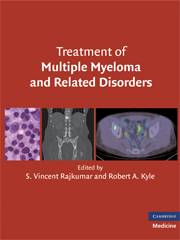Book contents
- Frontmatter
- Contents
- List of Contributors
- 1 DIAGNOSIS AND GENETIC CLASSIFICATION OF MULTIPLE MYELOMA
- 2 STAGING AND RISK-STRATIFICATION OF MULTIPLE MYELOMA
- 3 TREATMENT OF NEWLY DIAGNOSED MULTIPLE MYELOMA
- 4 MAINTENANCE THERAPY IN MULTIPLE MYELOMA
- 5 TREATMENT OF RELAPSED AND RELAPSED/REFRACTORY MULTIPLE MYELOMA
- 6 DIAGNOSIS AND TREATMENT OF MYELOMA BONE DISEASE
- 7 TREATMENT OF MYELOMA-RELATED COMPLICATIONS
- 8 AUTOLOGOUS TRANSPLANTATION FOR MULTIPLE MYELOMA
- 9 ALLOGENEIC STEM CELL TRANSPLANTATION FOR MULTIPLE MYELOMA
- 10 IMMUNOGLOBULIN LIGHT CHAIN AMYLOIDOSIS
- 11 WALDENSTRÖM MACROGLOBULINEMIA/LYMPHOPLASMACYTIC LYMPHOMA
- 12 DIAGNOSIS, RISK-STRATIFICATION, AND MANAGEMENT OF SOLITARY PLASMACYTOMA
- 13 MONOCLONAL GAMMOPATHY OF UNDETERMINED SIGNIFICANCE AND SMOLDERING MULTIPLE MYELOMA
- 14 DIAGNOSIS AND TREATMENT OF POEMS SYNDROME
- Index
- References
7 - TREATMENT OF MYELOMA-RELATED COMPLICATIONS
Published online by Cambridge University Press: 11 July 2009
- Frontmatter
- Contents
- List of Contributors
- 1 DIAGNOSIS AND GENETIC CLASSIFICATION OF MULTIPLE MYELOMA
- 2 STAGING AND RISK-STRATIFICATION OF MULTIPLE MYELOMA
- 3 TREATMENT OF NEWLY DIAGNOSED MULTIPLE MYELOMA
- 4 MAINTENANCE THERAPY IN MULTIPLE MYELOMA
- 5 TREATMENT OF RELAPSED AND RELAPSED/REFRACTORY MULTIPLE MYELOMA
- 6 DIAGNOSIS AND TREATMENT OF MYELOMA BONE DISEASE
- 7 TREATMENT OF MYELOMA-RELATED COMPLICATIONS
- 8 AUTOLOGOUS TRANSPLANTATION FOR MULTIPLE MYELOMA
- 9 ALLOGENEIC STEM CELL TRANSPLANTATION FOR MULTIPLE MYELOMA
- 10 IMMUNOGLOBULIN LIGHT CHAIN AMYLOIDOSIS
- 11 WALDENSTRÖM MACROGLOBULINEMIA/LYMPHOPLASMACYTIC LYMPHOMA
- 12 DIAGNOSIS, RISK-STRATIFICATION, AND MANAGEMENT OF SOLITARY PLASMACYTOMA
- 13 MONOCLONAL GAMMOPATHY OF UNDETERMINED SIGNIFICANCE AND SMOLDERING MULTIPLE MYELOMA
- 14 DIAGNOSIS AND TREATMENT OF POEMS SYNDROME
- Index
- References
Summary
INTRODUCTION
Multiple myeloma (MM) is hampered by a number of complications that can result in a poor quality of life and in many instances are contributory causes of death. In this chapter, the treatment of the most frequent complications such as bone disease, renal function impairment, anemia, infections, nervous system involvement, and extramedullary disease are reviewed.
SKELETAL COMPLICATIONS
Incidence and pathogenesis
Bone involvement is the most frequent clinical complication in patients with MM. In this sense, approximately 70% of patients have lytic bone lesions with or without osteoporosis and other 20% have severe osteoporosis without lytic lesions. The skeletal involvement leads to bone pain and can result in pathological fractures. Bone disease in MM results from an imbalance between increased resorption and decreased bone formation. Thus, both malignant plasma cells and bone marrow stromal cells can produce osteoclast-stimulating cytokines such as interleukin-1β (IL-1β), IL-6, and tumor necrosis factor-α; (TNF-α). Moreover, the interaction between the receptor activator of nuclear factor-κB (NF-κB) (RANK) and RANK ligand can play an important role in cancer-associated bone disease. It seems that the bone involvement in MM is the consequence of an alteration in the cytokine production by the bone marrow microenvironment, thus resulting in the uniform pattern of skeletal involvement. Thus, it has been observed by these authors that patients without lytic lesions at the time of diagnosis usually do not develop lytic lesions later in the course of the disease. These patients commonly have or develop progressive osteopenia resulting in rib or vertebral fractures.
- Type
- Chapter
- Information
- Treatment of Multiple Myeloma and Related Disorders , pp. 76 - 85Publisher: Cambridge University PressPrint publication year: 2008



